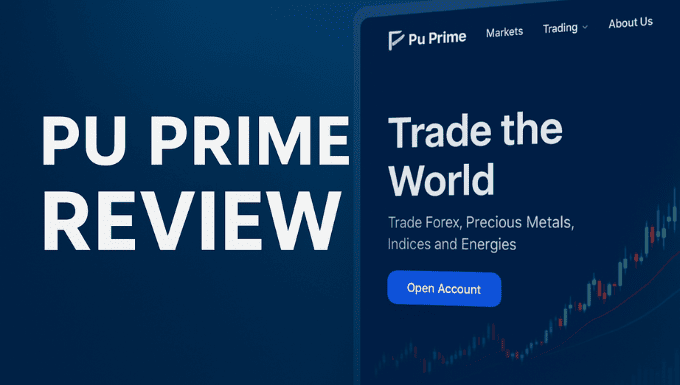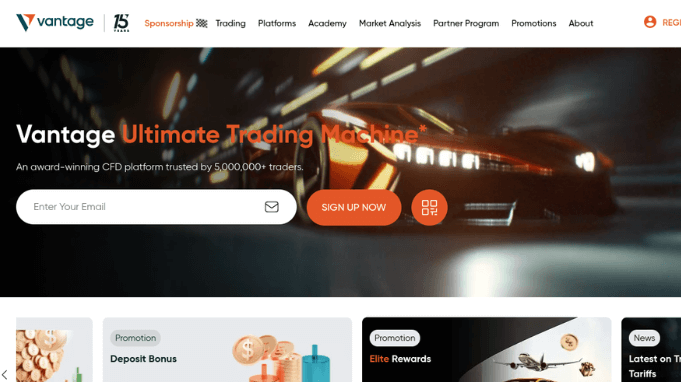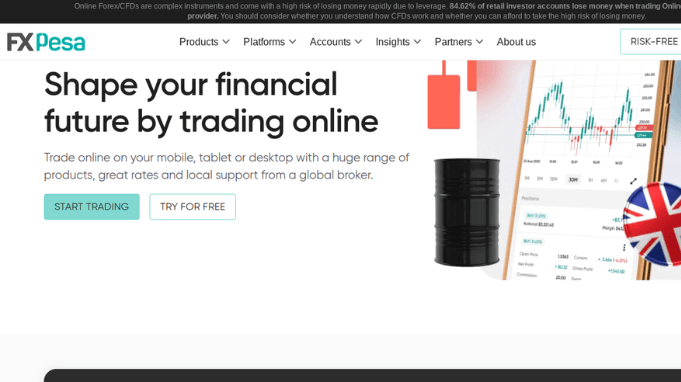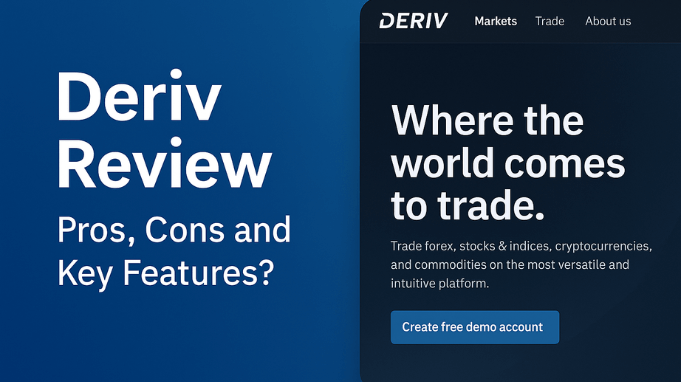If you are you’re researching for a detailed PU Prime Review then this review provides a comprehensive and practical breakdown, covering regulation and safety, pricing (including spreads, commissions, and swaps), platforms (MT4/MT5/mobile), account types, execution, deposits and withdrawals, support, education, and real-world pros and cons. We also compare PU Prime vs XM, IC Markets, and Exness, so you can see how it stacks up in the areas that matter to day traders, swing traders, and investors.
Quick fact check: PU Prime operates multiple entities, including authorization under the Mauritius FSC (License GB23202672) and South Africa’s FSCA (FSP 52218). Its help center also cites an ASIC-licensed Australian entity for Australian clients and an FSA Seychelles entity.
PU Prime Overview
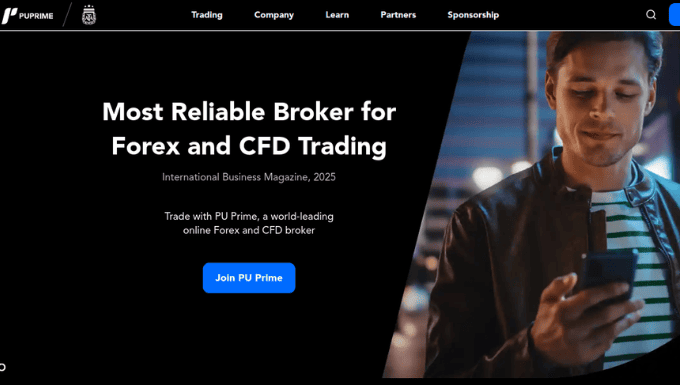

PU Prime is a multi-asset CFD broker offering Forex, indices, commodities (including energies), metals, shares, and ETFs via MetaTrader 4 (MT4), MetaTrader 5 (MT5), and its own mobile app. Like many global brokers, PU Prime employs a multi-entity structure to serve clients across different regions, ensuring compliance with local regulations.
At a glance:
- Markets: FX majors/minors/exotics, indices, metals, energies, shares/ETFs (availability varies by entity).
- Platforms: MT4, MT5, mobile.
- Account types: Standard, Prime (raw spread + commission), and others—details may vary by region.
- Funding options include cards, bank transfers (local & international), e-wallets, and crypto methods, depending on your location.
Regulation and Safety
- Mauritius: PU Prime Ltd—FSC Mauritius License GB23202672. The FSC is the non-bank financial markets regulator in Mauritius.
- South Africa: PU Prime (Pty) Ltd—FSCA Financial Services Provider (FSP 52218). The FSCA is South Africa’s market conduct regulator.
- Australia: PU Prime Trading Pty Ltd—ASIC AFSL 410681 (for Australian clients via puprime.au). ASIC is Australia’s federal financial regulator.
- Seychelles: PU Prime Ltd—FSA Seychelles License SD050 (per PU Prime pages that describe the brand’s structure). Note: Availability may vary by country.
What this means for you: Multi-entity regulation is common in the CFD industry. It improves geographical coverage and may allow different leverage and product offerings by jurisdiction. Always confirm which entity will onboard you (shown during sign-up and in your Client Portal) and read the legal documents applicable to that entity.
Account Types and Minimums
PU Prime advertises several account types. Naming can vary by region, but the common structure is:
- Standard – spread-only pricing, broader accessibility.
- Prime / Raw – access to raw interbank spreads with a commission per lot; marketed for active traders/EA users. PU Prime’s help center references an average EUR/USD spread of 0.0 pips on Prime, plus a $7 per standard lot round-trip commission (check your region).
- Others – Some regions list additional variants (e.g., Islamic/swap-free, demo). Check the Account Types page for the setup specific to your country.
Funding minimums and currencies: PU Prime’s deposits & withdrawals page outlines the supported methods (local bank, international bank wire, cards, e-wallets, and crypto), timeframes, and fees (note that some methods may show 0% commission by PU Prime, but your payment provider may still charge). The minimum example shown for local transfer is $50, although this amount can vary by region and method. Always verify in your Client Portal.
Spreads, Commissions and Swaps
- Spreads: PU Prime publishes indicative spreads on its website; live spreads fluctuate with market liquidity and your entity/platform.
- Commissions: On Prime accounts, PU Prime charges $7 per standard lot (round-turn) on FX; stock CFDs may carry specific commissions.
- Swaps: Overnight financing depends on the instrument and entity. Check the symbol specification in MT4/MT5 or the mobile app.
Tip: If you scalp or run EAs, compare all-in cost (typical spread + per-lot commission + swaps) across several brokers at your usual trading hours.
Platforms and Tools
- MT4/MT5: Full suite with charting, indicators, EAs, and mobile/desktop/web access. Suitable for scalpers and algo traders.
- PU Prime App: A streamlined mobile experience with account management and trading access.
Execution & Infrastructure: PU Prime markets “ultra-fast trade execution” in support pages and site copy. Execution quality depends on your location, server proximity, and liquidity routing. Consider testing with a demo and a small live account during your usual sessions.
Deposits and Withdrawals
PU Prime offers multiple funding options, including local and international bank transfers, credit and debit cards, e-wallets, and cryptocurrency choices. The site lists some methods as instant and offering 0% commission (by PU Prime), and supports multi-currency funding. However, processing times still depend on the technique and region. Always confirm fees and timelines in the Deposit/Withdrawal section of your Client Portal.
PU Prime’s Deposit & Withdrawal Policy (PDF) adds formal details on processes, timeframes, and handling.
Customer Support and Education
PU Prime advertises 24/5 live support and publishes site reviews and news/notification pages. As with all brokers, real-world experiences vary. We recommend testing support via live chat with practical questions (e.g., proof of funds requirements, bank transfer SLAs, or symbol-specific swap tables) before depositing a significant amount.
Reputation: What Are Traders Saying?
Public sentiment on any broker is typically mixed:
- Positive themes (from broker’s curated reviews): ease of use, multiple markets, responsive support.
- Negative themes (from independent forums): spread spikes, slippage, pricing disputes—typical for high-volatility periods, but some users allege unfair treatment. Example: claims on Forex Peace Army threads and reviews include price discrepancies and spread complaints. Treat all forum posts as allegations; investigate carefully, request trade audit trails from the broker, and compare tick data where possible.
Who Is PU Prime Best For?
- Cost-conscious day traders/scalpers who prefer raw spread + commission models and MT4/MT5.
- Multi-asset traders who want indices/commodities/metals alongside FX.
- Traveling traders/mobile-first users who value a modern app.
Who might look elsewhere: If you need top-tier jurisdiction coverage only (e.g., trading strictly under FCA-UK or CySEC), or if you want specialist features like cTrader, you may want to compare alternatives.
PU Prime vs XM vs IC Markets vs Exness
Below is a condensed comparison of regulations, typical pricing postures, and platform ranges. Always confirm your onboarding entity and local product list.
Regulation Snapshot
| Broker | Key Entities & Regulators (illustrative, not exhaustive) |
| PU Prime | FSC Mauritius (GB23202672); FSCA South Africa (FSP 52218); ASIC Australia (AFSL 410681); FSA Seychelles (SD050). |
| XM | Group includes CySEC (120/10), FSC Mauritius (GB23202700), FSA Seychelles (SD190), and FSC Belize (000261/27). |
| IC Markets | FSA Seychelles (SD018) is used for global operations, a separate CySEC entity is utilized for EU operations, and Kenya (CMA) is listed on the local site for IC Markets KE. |
| Exness | A mix of FCA UK, CySEC, FSCA SA, FSA Seychelles, among others; the specific entity depends on the operations, with a separate CySEC entity for EU operations and particular regions. |
Note: Jurisdictional. Additionally, liability and protections differ widely. Check your account’s Terms, Client Agreement, and Compensation Scheme coverage.
Pricing & Accounts (High-Level)
| Broker | Spread Style | Raw/ECN Option | Example Notes |
| PU Prime | Standard (spread-only) + Prime (raw + commission) | Yes | Help center cites EUR/USD avg 0.0 on Prime with $7 RT per lot; verify in your platform. |
| XM | Standard, Micro, Zero/Ultra-Low variants | Yes | $5 min deposit on some accounts; MT4/MT5 platforms. |
| IC Markets | Raw Spread accounts + Standard | Yes | Markets average 0.1 pips EUR/USD on Raw, plus a $ 3.50 per-side commission. cTrader/MT4/MT5. |
| Exness | Standard, Raw/Zero/Pro | Yes | Broad global reach, fast/automated withdrawals, and marketing claims. MT4/MT5/Exness Terminal. |
Platforms
| Broker | Platforms |
| PU Prime | MT4, MT5, Mobile App. |
| XM | MT4, MT5, web tools. |
| IC Markets | MT4, MT5, cTrader; extensive algo support. |
| Exness | MT4, MT5, Exness Terminal (web). |
Funding & Payouts
| Broker | Funding Methods (examples) | Notable Claims/Notes |
| PU Prime | Local/international banks, cards, e-wallets, and crypto; some methods have a 0% broker fee. “Instant” is displayed for some local rail services. Check your portal. | See Deposit & Withdrawal Policy PDF for formal rules. |
| XM | Cards, wires, e-wallets; promotions vary by region. | Multi-regulated group; offerings differ by entity. |
| IC Markets | Cards, wires, e-wallets; strong infrastructure pitch. | Raw pricing posture for algorithmic and scalping traders. |
| Exness | Broad local methods; fast/automated withdrawals marketing. | Claims 98% instant/automatic processing; verify with your method. |
Real-Life Use Cases and Scenarios
1) Day Trader Running an EA During London/NY Overlap
- Your need: raw spreads, stable connection, predictable commissions.
- PU Prime fit: Prime account’s raw + commission model can be competitive; confirm your latency to the trade server and measure slippage on a small live account for 1–2 weeks. Check the swap if holding after New York close.
- Compare: IC Markets Raw has long marketed ultra-tight spreads and low commissions for EA traders; Exness Raw/Zero also targets algorithmic users and high-frequency trading styles.
2) Swing Trader on Metals (XAUUSD)
- Your need: reasonable spreads overnight, transparent swaps, dependable funding.
- PU Prime fit: Verify XAUUSD swap rates in MT4/MT5 symbol specifications and ensure deposit/withdrawal methods align with your bank/currency.
- Compare: Exness emphasizes gold spreads, while XM offers multiple account types with varying fee structures. Try both on demo + small live before committing.
3) Mobile-First Newcomer
- Your need: a clean mobile app, strong chat support, and clear funding.
- PU Prime fit: The PU Prime App focuses on convenience; test KYC and a small deposit/withdrawal round-trip to validate local rails.
- Compare: XM invests heavily in multilingual support; IC Markets and Exness also provide modern portals and help centers.
PU Prime Pros and Cons
| Pros | Cons |
| Multi-entity regulatory footprint (FSC Mauritius, FSCA South Africa; ASIC for AU; FSA Seychelles noted). | Mixed third-party reviews; some forum allegations about pricing/spreads (treat as unverified; request audit trails). |
| Prime account with raw spreads + fixed commission; help center cites EUR/USD avg 0.0 + $7 RT (verify live). | Live costs vary by market conditions; published spreads are indicative only. |
| Robust instrument list (FX, indices, metals, energies, shares/ETFs). | No cTrader platform choice; the main options are MT4/MT5 + app (which may matter to cTrader users). |
| Multiple funding methods; some 0% broker fee rails and “instant” options by method/region. | Funding menu varies by jurisdiction; FX/CFD funding is always subject to provider/FX conversion fees. |
| Mobile app alongside the MetaTrader stack. | Education/community depth may be smaller than the largest global brands. |
Case Study: Testing All-In Cost on EUR/USD (Illustrative)
Goal: Compare all-in cost (spread + commission) over a week on a Prime/Raw-style account during the London/NY overlap.
Method (what to do):
- Open small live accounts with PU Prime, IC Markets Raw, and Exness Raw/Zero.
- At the same local time each day (e.g., 14:30–16:30 London), record typical spread snapshots every 5 minutes for EUR/USD.
- Convert commission to pips (commission per lot ÷ $10 per pip on a standard lot).
- Calculate all-in = typical spread (pips) + commission (pips).
- Run for 5–10 trading days; discard news spikes to avoid skew.
Why this matters: Marketing pages often quote tight numbers (e.g., 0.0 to 0.1 pips), but your actual cost can vary depending on your latency and trade size. IC Markets, for example, advertises 0.1 pip average on EUR/USD on Raw with $3.5 per side; PU Prime cites $7 RT on its Prime; Exness offers Raw/Zero variants. Your mileage will vary—measure it.
Risk Management and Client Protection
CFDs are complex and highly leveraged. Strong personal process matters more than broker choice:
- Entity & Documents: Confirm your onboarding entity, read the Client Agreement, and review complaint handling and dispute resolution procedures.
- Funding hygiene: Use the same method for deposits and withdrawals where possible. Keep records/screenshots.
- Leverage controls: Volatility events (CPI, NFP, rate decisions) can trigger slippage and widened spreads across brokers—plan position sizes and stops accordingly.
- Verification: Where available, verify licenses via official regulator registers (e.g., FSC Mauritius, FSCA South Africa search tools).
How PU Prime Compares: Quick Verdicts by Trader Type
- Scalpers/EA traders: PU Prime’s Prime account pricing structure is competitive in theory. Compare side by side with IC Markets Raw and Exness Raw/Zero during your exact session, and consider the server latency to your VPS.
- Discretionary intraday traders: Platform parity (MT4/MT5) means the deciding factors are support responsiveness, funding convenience, and execution consistency during volatile minutes.
- Longer-term CFD traders: Factor swaps across brokers; differences can outweigh small spread gaps.
- Mobile-first beginners: PU Prime’s app and 24/5 support messaging are positives; XM is known for broad education & multilingual support, while Exness emphasizes fast withdrawals and round-the-clock assistance.
Practical Onboarding Checklist (Step-by-Step)
- Confirm your entity at registration (e.g., FSC Mauritius vs. FSCA South Africa vs. others). Screenshot it.
- Read the Client Agreement and Risk Disclosure applicable to that entity.
- KYC: Prepare your government-issued ID and address proof (utility bill, bank statement), following the help center’s format.
- Platform install: MT4/MT5 or app; set server closest to your location (ask support if unsure).
- Funding test: Start with a small deposit, place a few minimal trades, and execute a withdrawal back to the source to validate timelines/fees.
- Cost tracking: Log typical spread/commission on the 3–4 instruments you’ll actually trade.
- Risk rules: Fix daily loss limits, maximum leverage per setup, and news blackout periods.
- Scale prudently after a clean deposit–trade–withdrawal cycle and 2–3 weeks of stable execution.
PU Prime vs Competitors: Feature-by-Feature Tables
Overall Pros & Cons by Broker (2025 Snapshot)
| Broker | Pros | Cons |
| PU Prime | Multi-entity regulation; Prim, prime (raw + commission); vari, ty of instruments; mult, ple funding methods, including local rails; mobi, and AE app. | Mixed third-party community reviews; no cTrader; published spreads are indicative only. |
| XM | Extensive global presence and education; low minimums on some accounts ($5); strong multilingual support. | Entity sprawl refers to the fact that offerings vary widely; spreads may be higher on spread-only accounts compared to raw peers. |
| IC Markets | Longstanding Raw pricing + cTrader; heavy algo/EA user base; infrastructure focus. | Recent legal headlines around the founder (Australia) add noise, though the company disputes claims. |
| Exness | Massive scale; marketing around fast/automated withdrawals; multiple pro/standard accounts; proprietary web terminal. | Some features vary by entity; research swap and stop-out specifics before committing. |
Pricing-Centric Comparison (Illustrative Reference)
| Aspect | PU Prime Prime | XM Ultra-Low/Zero | IC Markets Raw | Exness Raw/Zero |
| EUR/USD marketing example | Avg 0.0 + $7 RT/lot (help center) | Low spreads, account-dependent | Avg 0.1 + $3.5/side | Very tight spreads on Raw/Zero (varies) |
| Commission | $7 RT (FX) | Typically, on “Zero” type | $7 RT equiv. | Varies by account |
| Platforms | MT4/MT5 + App | MT4/MT5 | MT4/MT5/cTrader | MT4/MT5 + Terminal |
| Notes | Verify live hours & swaps | Minimum $5 on some | Popular with EAs | Strong funding rails/automation |
Citations: PU Prime (pricing claim); XM (account types/minimum); IC Markets (raw pricing); Exness (accounts & terminal).
Advanced Tips to Optimize Costs on PU Prime
- Choose the correct account: If you scalp or use EAs, a raw + commission model (e.g., Prime) typically trims the spread.
- Trade in liquid hours: London open and London–NY overlap offer tighter spreads for major FX pairs versus the Asia session.
- Measure slippage: Use a trade journal to record the requested versus filled prices, especially during news events.
- Watch swaps: If you hold positions overnight, test real swap charges over a week on your core symbols.
- Use local banks: Where available, local banks can expedite funding and reduce fees compared to international wires.
Frequently Asked Questions About PU Prime
1) Is PU Prime a safe broker?
PU Prime operates multiple regulated entities, including FSC Mauritius (GB23202672) and FSCA South Africa (FSP 52218), as well as an ASIC-licensed Australian arm and an FSA Seychelles entity, as referenced on PU Prime’s pages. Safety also depends on which entity you join. Always verify the entity before funding and read the Client Agreement for protections and risk disclosures.
2) What are PU Prime’s fees and spreads?
Pricing varies by account and market conditions. The Prime account is a raw spread + commission, with the help center citing an average of 0.0 pips for EUR/USD and a $7 round-turn. Standard accounts fold all costs into the spread. Check symbol specs in MT4/MT5 or the mobile app for live values.
3) Which platforms does PU Prime offer?
MT4, MT5, and a proprietary mobile app. MT4/MT5 support expert advisors and custom indicators; the app focuses on round-trip commission-free use and funding.
4) How fast are deposits and withdrawals?
PU Prime offers multiple payment methods (local/international bank transfers, cards, e-wallets, and cryptocurrencies). Some rails are shown as instant and 0% broker fee; processing time depends on the method and region. Review the Deposit/Withdrawal page and policy PDF, then test a small round-trip.
5) Is PU Prime good for scalping and EAs?
Potentially, yes—choose the Prime (raw + commission) model and measure all-in costs during your trading hours. Compare side-by-side with IC Markets Raw and Exness Raw/Zero, especially if you use a VPS near the trade server.
6) What’s the minimum deposit?
Minimums differ by method and entity; PU Prime’s pages list $50 for certain local bank rails, but confirm in your Client Portal.
7) How does PU Prime compare to XM, IC Markets, and Exness?
PU Prime competes with raw pricing on Prime accounts and broad instruments. IC Markets is popular with EAs and cTrader users; Exness emphasizes fast withdrawals and multiple pro accounts; XM offers low minimums and strong multilingual support. Your choice should be based on measured live costs, funding convenience, and entity coverage.
8) Are there any common complaints?
Third-party forums reveal a mix of experiences—some users report pricing or spread disputes during periods of volatility. Treat forum posts as allegations; request trade execution reports from support, and compare against independent tick data when possible.
9) Does PU Prime offer Islamic (swap-free) accounts?
Availability is region-specific. Check the Account Types section for your entity or ask live chat to enable swap-free status if eligible.
10) Can I verify PU Prime’s license?
Yes. Check PU Prime’s Regulation page, then cross-verify with the FSC Mauritius public register and the FSCA FSP search tool.
Final Verdict: Should You Trade With PU Prime?
PU Prime offers a comprehensive feature set for traders seeking MetaTrader access, multi-asset coverage, raw and commission pricing via Prime, and flexible funding options (including local rails in select regions). Its multi-entity regulatory footprint (FSC Mauritius, FSCA South Africa, ASIC for AU, FSA Seychelles) is in line with many global CFD brokers, though investor protections still vary by jurisdiction.
Bottom Line:
- If you’re a scalper/EA user, short-list PU Prime, IC Markets Raw, and Exness Raw/Zero, and measure live all-in costs during your exact trading windows.
- If you prefer the lowest minimums and a significant education hub, consider testing XM alongside.
- For funding convenience, run a quick deposit–trade–withdrawal trial to validate speed and fees.
Finally
If you ready to evaluate PU Prime for your strategy?
- Open a demo and a small live Prime account,
- Measure all-in costs on your instruments for 1–2 weeks, and
- Confirm funding/withdrawal turnaround with a small round-trip.
Use complex data not ads to determine if PU Prime is the best fit for you.
Risk Warning: CFDs are complex financial instruments and carry a high risk of losing money rapidly due to leverage. Only trade with money you can afford to lose, and always read the legal documents of your onboarded entity.
Vincent Nyagaka is the founder of Chweya, where he breaks down complex financial topics into simple insights. A trader since 2015, he uses his market experience to help readers better understand investing, trading, and personal finance.
